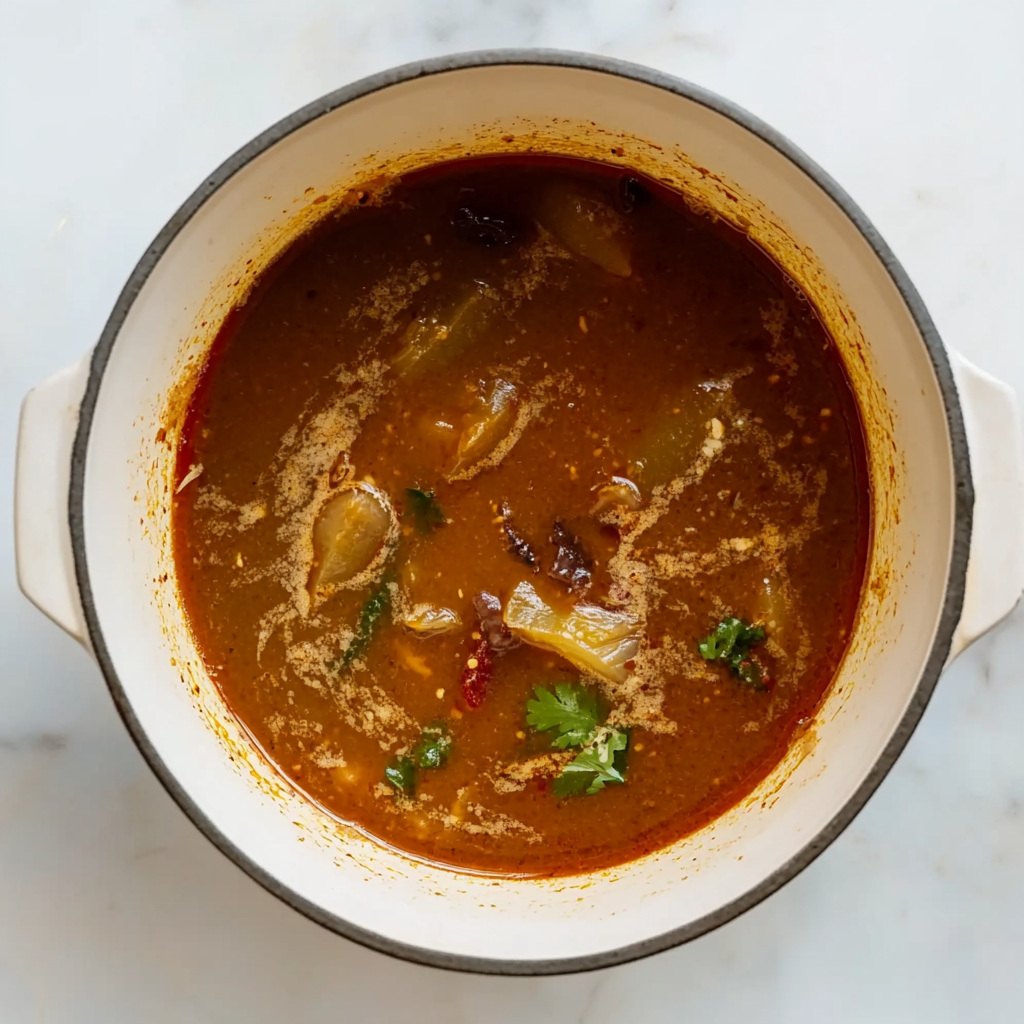Sharing is caring!
Nihari Beef Stew
Why You’ll Love Nihari Beef Stew?
There’s nothing quite like the rich, slow-cooked flavors of nihari beef stew—a dish that’s as comforting as it is aromatic. Originating from the royal kitchens of the Mughal Empire, this tender beef stew is simmered for hours with warming spices, resulting in a melt-in-your-mouth experience. Whether you’re craving a hearty weekend meal or a dish to impress guests, nihari beef stew delivers deep, layered flavors that make it unforgettable. Pair it with naan or steamed rice for the ultimate comfort food experience. For more warming dishes, try our roasted cauliflower salad as a refreshing side.
Table of Contents
- Ingredients to make Nihari Beef Stew
- Time needed to make nihari beef stew?
- Quick Steps to Make Nihari Beef Stew?
- Is nihari beef stew healthy and nutritious ?
- Can I make nihari beef stew healthier and still delicious?
- How to Serve Nihari Beef Stew?
- Avoid These Mistakes
- The best way to store leftover nihari beef stew
- Ready to give nihari beef stew a try?
- Frequently Asked Questions
Ingredients to make Nihari Beef Stew
- 2 lbs beef shank or bone-in beef (cut into chunks)
- 1/4 cup wheat flour (for thickening)
- 1/4 cup ghee or oil
- 2 medium onions (thinly sliced)
- 2 tbsp ginger-garlic paste
- 1 tbsp nihari masala (store-bought or homemade)
- 1 tsp red chili powder (adjust to taste)
- 1/2 tsp turmeric powder
- 1 tsp coriander powder
- 1 tsp cumin powder
- 6-8 cups water or beef broth
- Salt to taste
- Fresh cilantro and ginger juliennes (for garnish)
- Lemon wedges (for serving)
Optional Add-ins: Bone marrow for extra richness, or a pinch of saffron for aroma.
Time needed to make nihari beef stew?
Making authentic nihari beef stew requires patience but rewards you with deep, slow-cooked flavors. Here’s the breakdown:
- Prep Time: 20 minutes (marinating optional)
- Cook Time: 6–8 hours (slow cooker) or 3–4 hours (stovetop)
- Total Time: 6.5–8.5 hours
For a quicker version, try our 30-minute teriyaki noodles as a side while the stew simmers. The long cook time tenderizes the beef and blends spices perfectly—worth every minute!
Quick Steps to Make Nihari Beef Stew?
Step 1: Prepare the Meat and Spices
Start by trimming excess fat from the beef shank or stew meat, then cut it into large chunks. In a bowl, mix together nihari masala, ginger-garlic paste, turmeric, red chili powder, and salt. Coat the meat evenly with this spice blend.
Step 2: Sauté the Aromatics
Heat ghee or oil in a heavy-bottomed pot or slow cooker. Add sliced onions and sauté until golden brown. Stir in the marinated meat and sear on medium-high heat for 5-7 minutes to lock in flavors.
Step 3: Slow Cook for Tenderness
Pour in enough water or beef broth to cover the meat completely. Bring to a boil, then reduce heat to low. Cover and let it simmer for 6-8 hours (or 4 hours in a pressure cooker) until the beef is fall-apart tender.
Step 4: Thicken the Stew
Once the meat is cooked, whisk in besan (gram flour) or wheat flour slurry to thicken the gravy. Simmer for another 10-15 minutes until the stew reaches a rich, velvety consistency.
Step 5: Garnish and Serve
Finish with fresh ginger juliennes, chopped cilantro, green chilies, and a squeeze of lemon. Serve hot with naan or steamed rice for a hearty meal.
Is nihari beef stew healthy and nutritious ?
Nihari beef stew is packed with protein and essential nutrients, making it a hearty and nourishing meal. A single serving provides a good amount of iron, zinc, and B vitamins, which support energy levels and immune function. However, due to its slow-cooked nature, it can be high in fat, so moderation is key. For a lighter version, consider trimming excess fat from the beef or using leaner cuts.
If you’re looking for more protein-rich dishes, try this air-fryer sea bass recipe or explore teriyaki noodles with shrimp and steak for balanced meals. For additional slow-cooked inspiration, check out this slow-cooker beef stew or these Cuban black beans for fiber-rich alternatives.
Can I make nihari beef stew healthier and still delicious?
Absolutely! While traditional nihari beef stew is rich and indulgent, you can tweak the recipe for a lighter yet equally flavorful version. Here’s how:
1. Leaner Meat Choices
Opt for leaner cuts like beef shank or round instead of fattier options. Trim excess fat before cooking to reduce calories without sacrificing tenderness. Slow cooking ensures the meat stays juicy.
2. Reduce Oil & Ghee
Cut back on oil or ghee by using a non-stick pot and sautéing spices with broth instead. A splash of olive oil works well for a healthier fat alternative. For more ideas on balancing flavors, check out this slow-cooker beef stew guide.
3. Boost Veggies
Add carrots, celery, or spinach for extra fiber and nutrients. Pair it with a light roasted cauliflower salad to keep the meal balanced.
4. Whole Spices Over Blends
Use whole spices (cumin, coriander, cardamom) instead of pre-mixed powders to avoid additives. Toasting them enhances flavor naturally. For inspiration, explore this quick bean stew recipe.
Craving dessert? Try a lighter creamy cake or zesty lemon bread to round off your meal.
How to Serve Nihari Beef Stew?
Nihari beef stew is a rich, slow-cooked dish that pairs beautifully with traditional accompaniments. For an authentic experience, serve it hot with flaky naan bread or steamed basmati rice to soak up the flavorful gravy. A side of spiced lentils adds extra protein and texture.
For a refreshing contrast, pair it with cooling sides like cucumber raita or a simple cauliflower salad. A squeeze of lemon brightens the deep flavors, while chopped cilantro and ginger juliennes add freshness. If you’re serving a crowd, consider slow-cooked vegetable stew as an additional hearty option.
Avoid These Mistakes
Making nihari beef stew is rewarding, but a few missteps can affect flavor and texture. Here’s what to watch for:
1. Skipping the Browning Step
Browning the beef before slow-cooking is non-negotiable. It locks in juices and adds depth. For a similar depth in other dishes, check out our seared sea bass guide.
2. Overcrowding the Pot
Cook beef in batches to avoid steaming instead of searing. This ensures even caramelization. Learn more about proper searing techniques from this expert beef stew guide.
3. Rushing the Cooking Time
Nihari beef stew needs hours to tenderize. Shortcuts lead to tough meat. If pressed for time, try our quick teriyaki noodles instead.
4. Neglecting Spice Balance
Too much garam masala overpowers the dish. For perfectly balanced spices, refer to this Cuban black beans recipe’s seasoning approach.
5. Forgetting the Garnish
Fresh ginger, cilantro, and lemon brighten the rich stew. Missing these? Our citrus juice recipes can inspire vibrant pairings.
The best way to store leftover nihari beef stew
Proper storage keeps your nihari beef stew tasting fresh for days. Let it cool completely before transferring to airtight containers—glass works best to preserve flavor. Refrigerate for up to 4 days, or freeze portions for 3 months. For reheating, gently warm on the stove with a splash of water or broth to revive the rich gravy. Avoid microwaving, as it can dry out the tender beef. For more tips on extending shelf life, check our guide on storing seafood dishes or explore slow-cooked meal preservation. Pro tip: Freeze individual servings with herb-infused ice cubes for added freshness, inspired by bean stew hacks.
Ready to give nihari beef stew a try?
Now that you’ve discovered the rich flavors and comforting warmth of nihari beef stew, why not bring this slow-cooked delight to your table? Whether you’re craving a hearty weekend meal or planning a special gathering, this dish promises to impress. Pair it with our roasted cauliflower salad for a balanced feast or serve alongside teriyaki noodles for a fusion twist. For dessert, try our creamy cake or sip on refreshing carrot-pineapple juice to complete the experience. Happy cooking!
Frequently Asked Questions
What is Nihari beef stew?
Nihari beef stew is a slow-cooked, richly spiced dish originating from South Asia, featuring tender beef shanks simmered in a flavorful broth with aromatic spices like garam masala, ginger, and fennel.
How long does it take to cook Nihari beef stew?
Traditional Nihari beef stew requires 6-8 hours of slow cooking for optimal tenderness, but you can reduce the time to 3-4 hours using a pressure cooker.
Can I use chicken instead of beef for Nihari?
While beef is traditional, you can substitute chicken for a lighter version. Adjust cooking time to 1.5-2 hours since chicken cooks faster than beef.
What makes Nihari beef stew different from regular beef stew?
Nihari stands out with its complex spice blend, slow-cooked bone marrow richness, and thicker gravy consistency compared to Western-style beef stews.
Is Nihari beef stew spicy?
The spice level can be adjusted to preference. Traditional versions have mild heat, but you can increase chili or reduce it for a milder flavor.
Can I freeze leftover Nihari beef stew?
Yes, Nihari freezes well for up to 3 months. Store in airtight containers and reheat gently to preserve texture.










